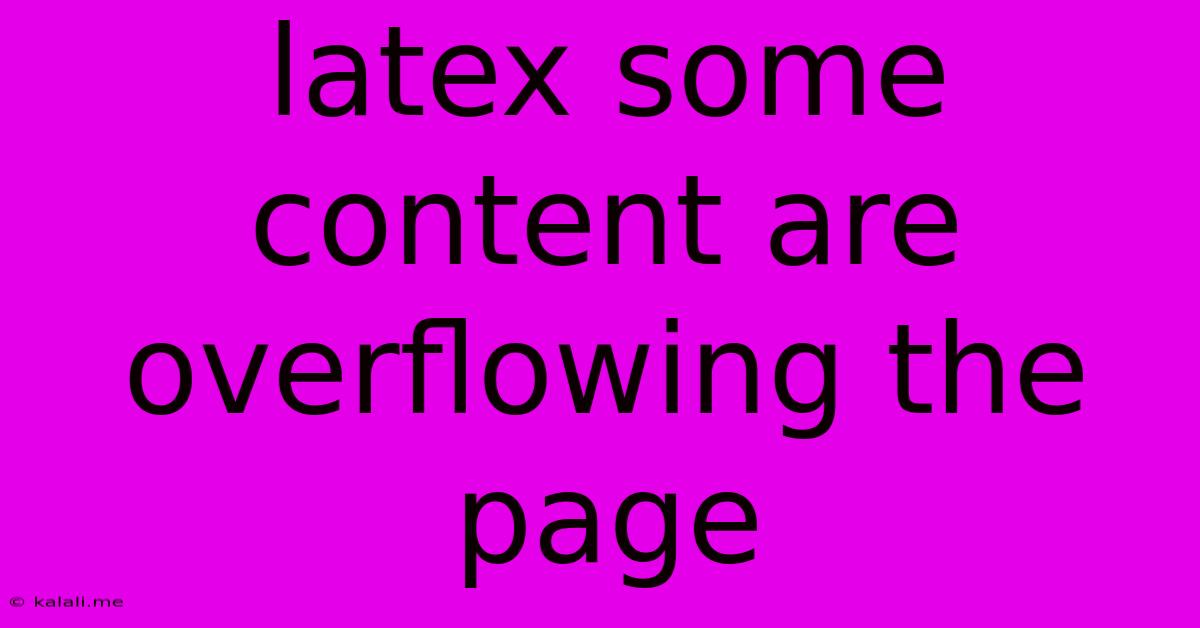Latex Some Content Are Overflowing The Page
Kalali
May 23, 2025 · 3 min read

Table of Contents
LaTeX Overflow: Troubleshooting and Solutions for Oversized Content
Have you ever meticulously crafted a beautiful LaTeX document, only to find that some content stubbornly refuses to stay within the page margins? This frustrating problem, where text, images, or tables overflow, is a common issue for LaTeX users. This article will guide you through troubleshooting and resolving various causes of overflowing content, ensuring your document is neatly formatted and ready for printing or digital distribution. We'll cover common culprits and provide practical solutions to get your LaTeX document looking its best.
Identifying the Source of the Overflow
Before diving into solutions, accurately identifying what is overflowing is crucial. Is it:
- Text? Long paragraphs, overly wide equations, or excessive text within a specific environment might be the problem.
- Images? Images that are too large for the text width will extend beyond the page margins.
- Tables? Wide tables frequently cause overflow, especially if they contain many columns or long text entries.
- Floats (Figures and Tables)? Incorrectly placed or configured floats can push content beyond the page boundaries.
Common Causes and Solutions
Let's explore the most frequent causes of overflow and their respective remedies.
1. Text Overflow:
- Problem: Long paragraphs or wide equations extend beyond the right margin.
- Solution:
- Line breaks: Ensure you're using proper line breaks (
\\) within long paragraphs to encourage text wrapping. - Paragraph formatting: Adjust paragraph indentation and spacing using commands like
\parindentand\parskip. - Page width adjustments: Consider using the
geometrypackage to alter page margins, providing more space for text. This involves adding\usepackage{geometry}in your preamble and then using the\geometrycommand to set margins as needed (e.g.,\geometry{a4paper, margin=1in}). - Hyphenation: Enable hyphenation using
\hyphenpenalty=10000(to disable) or adjusting the value to control the frequency of hyphenation. This can help improve text fitting. - Smaller font size: As a last resort, consider slightly reducing the font size for specific sections.
- Line breaks: Ensure you're using proper line breaks (
2. Image Overflow:
- Problem: Images extend beyond the page margins, often due to their original dimensions.
- Solution:
- Scaling images: Use the
graphicxpackage's\includegraphicscommand with thewidth=orscale=options to resize the image proportionally to fit within the text width. For example,\includegraphics[width=0.8\textwidth]{myimage.jpg}scales the image to 80% of the text width. - Clipping images: If you only need a portion of the image, consider using image editing software to crop it before inclusion in your LaTeX document.
- Scaling images: Use the
3. Table Overflow:
- Problem: Tables that are too wide or too tall to fit on a single page.
- Solution:
longtablepackage: For very long tables that span multiple pages, use thelongtablepackage. This allows tables to break across pages gracefully.- Rotating tables: Rotate the table 90 degrees using the
rotatingpackage. This can be useful for very wide tables. - Reducing column width: Examine the content of each column. Can any text be shortened or summarized? Consider using a smaller font size within the table.
- Breaking the table: If possible, split the table into smaller, more manageable tables.
4. Float Overflow:
- Problem: Figures or tables, even if individually sized correctly, might be pushed to the bottom of the page or onto the next page due to conflicts with other content.
- Solution:
Hplacement specifier: Use[H]as a placement specifier within thefigureortableenvironment. This forces the float to appear exactly where it's placed in the code (though it might still cause overflow if there's not enough space).!placement specifier: Use[!h](or[!htbp]) with caution. The!overrides LaTeX's placement algorithms, which can sometimes lead to less optimal results.- Manual placement: As a last resort, manually adjust the placement of floats using commands like
\vspace*.
By systematically examining these potential issues and applying the appropriate solutions, you can effectively resolve content overflow in your LaTeX documents. Remember that experimenting with different approaches may be necessary to achieve the best results for your specific document's layout. Always compile your document frequently to see the effects of your changes in real-time.
Latest Posts
Latest Posts
-
How Many Grams Of Sugar In A Pound
Jul 12, 2025
-
7am To 11am Is How Many Hours
Jul 12, 2025
-
If Your 35 What Year Was You Born
Jul 12, 2025
-
How Many Cups Is 1 Pound Of Cheese
Jul 12, 2025
-
30 X 30 Is How Many Square Feet
Jul 12, 2025
Related Post
Thank you for visiting our website which covers about Latex Some Content Are Overflowing The Page . We hope the information provided has been useful to you. Feel free to contact us if you have any questions or need further assistance. See you next time and don't miss to bookmark.